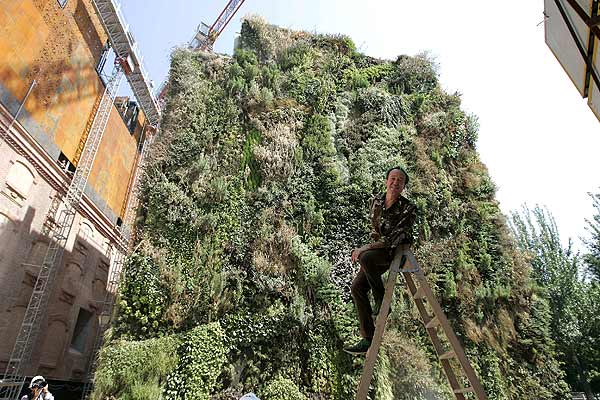
Herzog and de Meuron designed 40 Bond, a luxury residential project… Let’s forget about the expensive residences and comment on the incredible aluminum gate at street level.
With a graffiti-inspired form that twists and turns, the gate measures 55 meters high by 355 meters long… I just love it! Great design for everyone.


via CoolBoom
Photos by Iwan Baan
CaixaForum MadridMadrid gets a new contemporary art museum—complete with vertical garden of 15,000 plants
Swiss architects Herzog & de Meuron have converted a former power station for the Caixa Foundation
by Cristina Carrillo de Albornoz

The CaixaForum
MADRID. Madrid’s latest art museum, the CaixaForum, has opened in the heart of the city’s cultural district near the Prado, the Reina Sofia and the Thyssen-Bornemisza museums. The $94m project has been funded by the Caixa Foundation, the philanthropic arm of the Spanish bank, Caixa d’Estalvisi Pensions de Barcelona.
The 19th-century brick walls have been retained, but raised on piers so that visitors can walk underneath the building. There are two underground floors, while a two-floor attic storey of rusted iron surmounts the original building. The conversion has increased the floorspace five-fold—from 2,000 sq. m to 10,000 sq. m.
“The fact that its heavy mass is detached from the ground in apparent defiance of the laws of gravity is not a magic thing, given the possibilities of 21st-century technology,” says architect Jacques Herzog, “but a need to explore the limits of freedom. The CaixaForum has been conceived as an urban magnet, attracting not only art-lovers but all the people of Madrid and those from outside the city. We wanted to surprise. A building must be like a new outfit of clothes for the city—always a bit sexy.”
As striking as the architectural conversion is the 460 sq. m, 24-metre high vertical garden that takes up one wall of the square in front of the building. Comprising 15,000 plants of 250 different species, it has being designed by botanist Patrick Blanc.
“The garden is a dialogue with the Botanical Garden on the street and adjacent to the Prado,” says Herzog. “We love to make new things, to experiment with materials and create a very unusual encounter between the rough and the natural, the smooth and the artificial, to incorporate nature so there can be the smell of a garden where you would not expect it.”
The new museum will have a wide brief, hosting touring exhibitions as well as festivals of music and poetry, debates and education programmes. One of its main functions will be to show selections from the Caixa Foundation’s collection of more than 700 works, mainly dating from the 1980s to today. The opening show includes 37 works by contemporary artists such as Cindy Sherman, Cornelia Parker, Richard Long, Anselm Kiefer and Georg Baselitz (until 6 April).
“The Caixa Foundation pioneered collecting and showing the most avant-garde contemporary art in the 1980s,” says Jose F. Coronado, general director of the foundation. “Our philosophy was to use culture as a tool for social integration. We wanted to break the barriers that separate many people from art, music and the humanities.”
The gallery’s next exhibition will be “The Bread of the Angels”, with 45 paintings on loan from the Uffizi Gallery in Florence. Many of the works, including paintings by Botticelli, Luca Giordano and Parmigianino, have never before left Italy.
via Artnewspaper






No comments:
Post a Comment